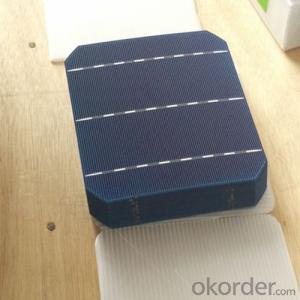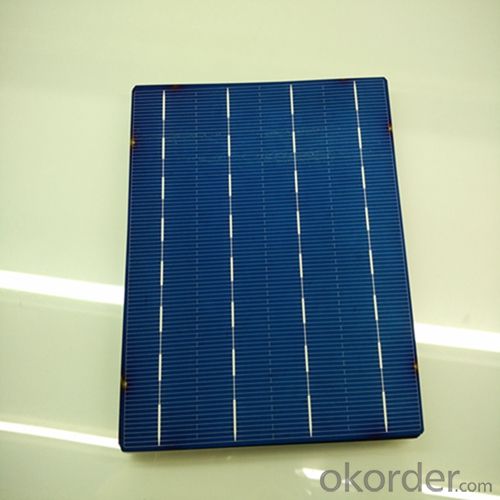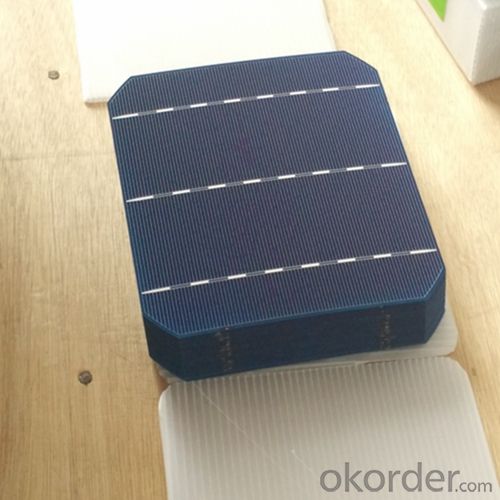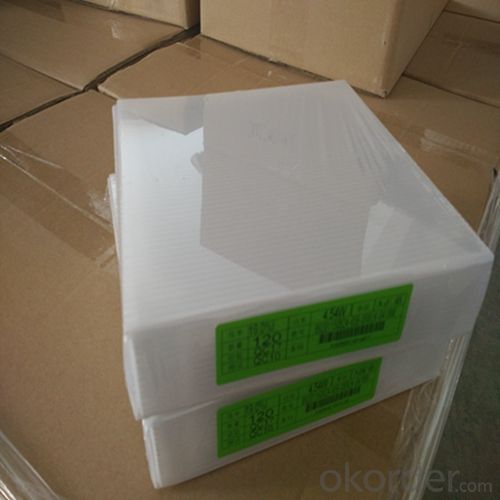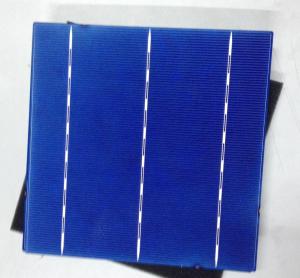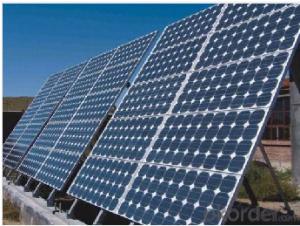Poly 156x156mm2 Solar Cells for Home Use - Class AA Quality
- Loading Port:
- Shanghai
- Payment Terms:
- TT OR LC
- Min Order Qty:
- 4600 watt
- Supply Capability:
- 6000000 watt/month
OKorder Service Pledge
OKorder Financial Service
You Might Also Like
The operation of a photovoltaic (PV) cell requires 3 basic attributes:
The absorption of light, generating either electron-hole pairs or excitons.
The separation of charge carriers of opposite types.
The separate extraction of those carriers to an external circuit.
In contrast, a solar thermal collector supplies heat by absorbing sunlight, for the purpose of either direct heating or indirect electrical power generation from heat. A "photoelectrolytic cell" (photoelectrochemical cell), on the other hand, refers either to a type of photovoltaic cell (like that developed by Edmond Becquerel and modern dye-sensitized solar cells), or to a device that splits water directly into hydrogen and oxygen using only solar illumination.Characteristic of Mono 156X156MM2 Solar Cells
You are gaining energy independence - add battery backup power for even greater energy security
The cost of electricity is only going to rise – insure against that rising cost
Adaptive cells change their absorption/reflection characteristics depending to respond to environmental conditions. An adaptive material responds to the intensity and angle of incident light. At the part of the cell where the light is most intense, the cell surface changes from reflective to adaptive, allowing the light to penetrate the cell. The other parts of the cell remain reflective increasing the retention of the absorbed light within the cell.[67]
In 2014 a system that combined an adaptive surface with a glass substrate that redirect the absorbed to a light absorber on the edges of the sheet. The system also included an array of fixed lenses/mirrors to concentrate light onto the adaptive surface. As the day continues, the concentrated light moves along the surface of the cell. That surface switches from reflective to adaptive when the light is most concentrated and back to reflective after the light moves along
Mechanical data and design
Format | 156mm x 156mm±0.5mm |
Thickness | 210μm±40μm |
Front(-) | 1.5mm bus bar (silver),blue anti-reflection coating (silicon nitride) |
Back (+) | 2.5mm wide soldering pads (sliver) back surface field (aluminium) |
Temperature Coefficient of Cells
Voc. Temp.coef.%/K | -0.35% |
Isc. Temp.coef .%/K | +0.024%/K |
Pm.Temp.coef. %/K | -0.47%/K |
Electrical Characteristic
Effiency(%) | Pmpp(W) | Umpp(V) | Impp(A) | Uoc(V) | Isc(A) | FF(%) |
18.35 | 4.384 | 0.526 | 8.333 | 0.63 | 8.877 | 78.39% |
18.20 | 4.349 | 0.526 | 8.263 | 0.63 | 8.789 | 78.54% |
18.05 | 4.313 | 0.525 | 8.216 | 0.63 | 8.741 | 78.32% |
17.90 | 4.277 | 0.524 | 8.161 | 0.625 | 8.713 | 78.04% |
17.75 | 4.241 | 0.523 | 8.116 | 0.625 | 8.678 | 77.70% |
17.60 | 4.206 | 0.521 | 8.073 | 0.625 | 8.657 | 77.36% |
17.45 | 4.170 | 0.519 | 8.039 | 0.625 | 8.633 | 76.92% |
17.30 | 4.134 | 0.517 | 8.004 | 0.625 | 8.622 | 76.59% |
17.15 | 4.096 | 0.516 | 7.938 | 0.625 | 8.537 | 76.80% |
17.00 | 4.062 | 0.512 | 7.933 | 0.625 | 8.531 | 76.18% |
16.75 | 4.002 | 0.511 | 7.828 | 0.625 | 8.499 | 75.34% |
16.50 | 3.940 | 0.510 | 7.731 | 0.625 | 8.484 | 74.36% |
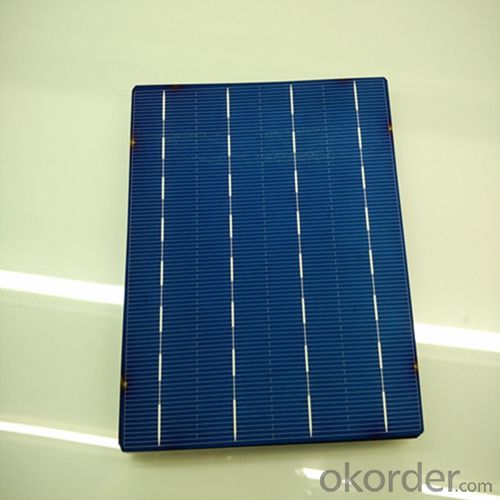
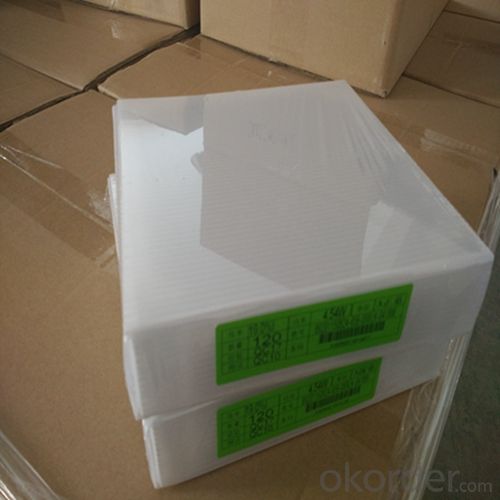
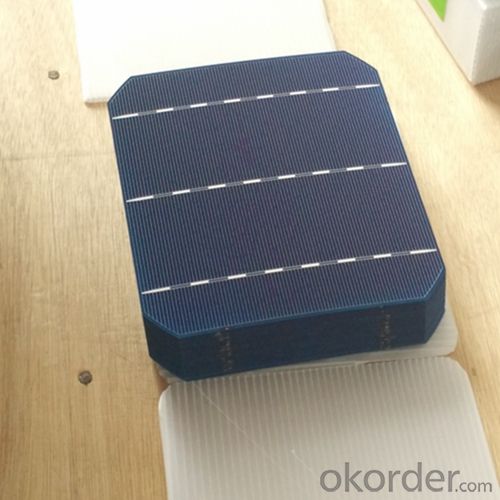

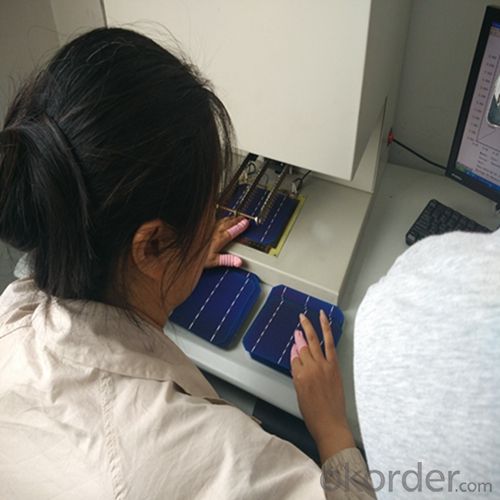 FAQ
FAQ
Q: What price for each watt?
A: It depends on the quantity, delivery date and payment terms, generally Large Quantity and Low Price
Q: What is your size for each module? Can you tell me the Parameter of your module?
A: We have different series of panels in different output, both c-Si and a-Si. Please take the specification sheet for your reference.
Q: What is your size for each module? Can you tell me the Parameter of your module?
A: We have different series of panels in different output, both c-Si and a-Si. Please take the specification sheet for your reference.
- Q: Can solar cells be used in emergency lighting?
- Yes, solar cells can be used in emergency lighting. Solar cells convert sunlight into electricity, which can then be stored in batteries for use during emergencies or power outages. This makes solar-powered emergency lighting a reliable and sustainable option.
- Q: What is the impact of shading on solar cell performance?
- The impact of shading on solar cell performance is significant as even a small amount of shading can significantly reduce the overall efficiency and output of the solar cell. Shading can create "hot spots" on the cell, leading to increased resistance and decreased current flow. This can result in a loss of power generation and reduced performance. Therefore, it is crucial to minimize shading and ensure unobstructed sunlight exposure to maximize the performance and efficiency of solar cells.
- Q: What is the impact of solar cells on reducing energy poverty?
- Solar cells have a significant impact on reducing energy poverty by providing access to clean and affordable electricity in remote and underserved areas. By harnessing the power of the sun, solar cells offer a sustainable and renewable energy solution, eliminating the reliance on fossil fuels and costly infrastructure. This empowers communities to meet their energy needs, improve living conditions, and promote economic growth while reducing greenhouse gas emissions and combating climate change.
- Q: How do solar cells perform in tropical climates?
- Solar cells perform well in tropical climates due to the abundance of sunlight and high temperatures. The intense sunlight provides optimal conditions for solar energy generation, allowing the cells to produce electricity efficiently. However, the high temperatures can cause some decrease in performance, as solar cells are sensitive to heat. Proper maintenance and cooling techniques can mitigate this issue and ensure consistent performance. Overall, solar cells are highly effective in tropical climates and can play a significant role in meeting the energy demands of these regions.
- Q: Can solar cells be used to power farms or agricultural operations?
- Yes, solar cells can be used to power farms or agricultural operations. Solar energy can be harnessed through solar panels or solar arrays to generate electricity, which can then be used to power various farming activities such as irrigation systems, livestock operations, or running farm machinery. Solar power offers a sustainable and environmentally friendly alternative to traditional energy sources, reducing reliance on fossil fuels and contributing to the overall sustainability of agricultural practices.
- Q: Can solar cells be used in underwater vehicles?
- Yes, solar cells can be used in underwater vehicles. However, their efficiency may be significantly reduced due to limited sunlight penetration through water. Specialized solar cells designed for underwater use can be utilized to generate power for these vehicles, but alternative power sources such as batteries or fuel cells are often used for efficient operation underwater.
- Q: Is the Photovoltaic cell panel good to save the energy?
- Yes, after being used and tested for years in the market, the photovoltaic cell panel is known to be very good to save energy.
- Q: Can solar cells be used in agricultural irrigation systems?
- Yes, solar cells can be used in agricultural irrigation systems. Solar-powered irrigation systems use solar panels to convert sunlight into electricity, which can then power pumps or other irrigation components. This renewable energy source can help reduce reliance on fossil fuels and provide a sustainable solution for irrigation in agricultural settings.
- Q: How do solar cells handle snow or ice accumulation?
- Solar cells are designed to handle snow or ice accumulation by having a smooth, glass-like surface that allows most of the snow or ice to slide off. Additionally, solar cells generate heat when exposed to sunlight, which helps to melt any remaining snow or ice.
- Q: Are there any library or exhibition halls where I can show students at school how the solar cells works?
- Why don't you arrange a tour to the solar cell library in downtown?
Send your message to us
Poly 156x156mm2 Solar Cells for Home Use - Class AA Quality
- Loading Port:
- Shanghai
- Payment Terms:
- TT OR LC
- Min Order Qty:
- 4600 watt
- Supply Capability:
- 6000000 watt/month
OKorder Service Pledge
OKorder Financial Service
Similar products
Hot products
Hot Searches
Related keywords


